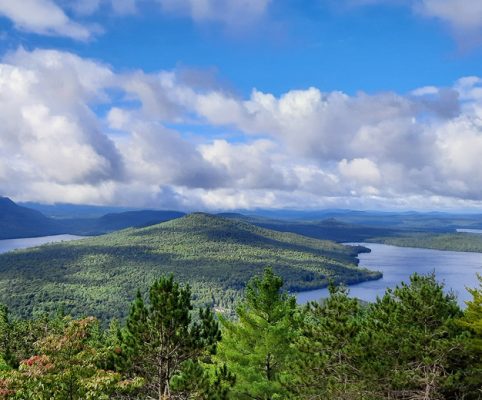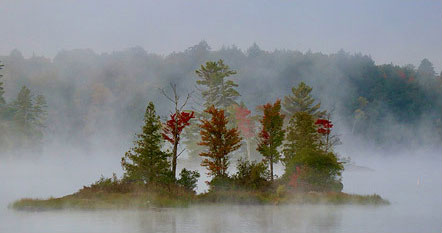By Jess Kelley, Donor Database Manager
Tuesday, July 15, 2025
Have you ever noticed how a walk in the woods can leave you feeling calmer, clearer, and just… better?
That feeling isn’t just a pleasant coincidence — it’s also backed by science. Forests release powerful natural compounds called phytoncides that can actually enhance your health. From improving immune function to lowering stress and anxiety, spending time in nature, especially among trees, is one of the most accessible and enjoyable wellness practices around. In this blog, we’ll dive into what phytoncides are, how they impact your body, and how you can reap the benefits in the wild areas of the Adirondack Park.

What Are Phytoncides and How Does Your Body Benefit from Them?
Phytoncides (pronounced “fight on sides”) are volatile organic compounds (VOCs) released by trees and plants, especially conifers like spruces, pines, and firs. These compounds serve as a natural defense system, protecting plants from harmful insects and bacteria. When we inhale phytoncides, our bodies respond in surprisingly positive ways: strengthening our immune systems, calming our nervous systems, and even improving our sleep.
- Immune Boost: Phytoncides increase the number and activity of a type of white blood cells called natural killer (NK) cells, which fight infections and tumors.
- Reduced Stress: Forest time significantly lowers cortisol, a stress hormone, and adrenaline, both of which can also help to lower stress levels and blood pressure.
- Better Sleep: Reduced stress and increased relaxation can lead to better sleep. A relaxed nervous system helps us sleep more soundly and achieve a better level of deep, restorative sleep.
- Improved Mood and Focus: Exposure to nature is linked to lower anxiety and better emotional balance. It can help you focus by giving your cognitive brain a break and reducing “directed attention fatigue,” a phenomenon where prolonged focus on a single task or multiple tasks can lead to mental exhaustion.
Even short sessions of just 15–20 minutes can make a measurable difference, but the more time you spend in the wild areas of the park, the more benefits you receive. Some studies show that the benefits of spending even just two hours in a forest can last up to a week and camping or backpacking in the forest for 2-3 days can have health benefits that last for a month or more!
 Forest Bathing: The Art and Science of Slowing Down
Forest Bathing: The Art and Science of Slowing Down
You don’t have to be an elite athlete or go on a long hike in the remote wilderness to enjoy the benefits of phytoncides. Shinrin-yoku, or “forest bathing,” is a Japanese practice of mindfully immersing yourself in a natural setting. Unlike a hike or workout, forest bathing is about being, not doing. You’re encouraged to slow your pace, use all your senses, and let go of distractions. The goal? To breathe deeply and absorb the atmosphere of the forest and reconnect with your body and surroundings. Here are some tips for getting the most out of your wilderness adventure:
- Spend 2 hours per week in nature, or break it up into shorter, 20-minute sessions.
- Choose areas with mature trees and minimal traffic noise.
- Move slowly, breathe deeply, use all five senses.
- Leave devices behind and try to remain quiet and present.

The Adirondacks: A Natural Prescription for Wellness
The Adirondack Park in upstate New York is one of the best places in the U.S. to experience the health benefits of nature. With six million acres of protected lands, clean air, and a dense mix of phytoncide-rich trees, it’s a sanctuary for the body and mind.
Great spots to explore:
- Paul Smith’s VIC: 25 miles of trails through diverse terrain.
- The Wild Center: A hands-on, family-friendly place to connect with forest ecology.
- John Brown Farm: Easy-access trails with historical context.
- High Peaks Wilderness: Deep forest immersion for more adventurous visitors.
Final Thoughts: A Breath of Forest Air Might Be the Medicine You Need
In our fast-paced world, forests remind us to slow down, breathe deep, and reconnect — with ourselves and the earth. Whether it’s an afternoon hike in the High Peaks of the Adirondacks or a quiet moment resting in an old-growth forest, nature is always waiting to restore and recalibrate you.
So go ahead—step outside, find some trees, and just… breathe.

